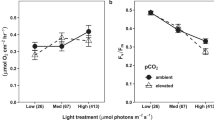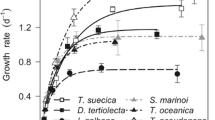Abstract
The response of marine phytoplankton to the ongoing increase in atmospheric pCO2 reflects the consequences of both increased CO2 concentration and decreased pH in surface seawater. In the model diatom Thalassiosira weissflogii, we explored the effects of varying pCO2 and pH, independently and in concert, on photosynthesis and respiration by incubating samples in water enriched in H2 18O. In long-term experiments (~6-h) at saturating light intensity, we observed no effects of pH or pCO2 on growth rate, photosynthesis or respiration. This absence of a measurable response reflects the very small change in energy used by the carbon concentrating mechanism (CCM) compared to the energy used in carbon fixation. In short-term experiments (~3 min), we also observed no effects of pCO2 or pH, even under limiting light intensity. We surmise that in T. weissflogii, it is the photosynthetic production of NADPH and ATP, rather than the CO2-saturation of Rubisco that controls the rate of photosynthesis at low irradiance. In short-term experiments, we observed a slightly higher respiration rate at low pH at the onset of the dark period, possibly reflecting the energy used for exporting H+ and maintaining pH homeostasis. Based on what is known of the biochemistry of marine phytoplankton, our results are likely generalizable to other diatoms and a number of other eukaryotic species. The direct effects of ocean acidification on growth, photosynthesis and respiration in these organisms should be small over the range of atmospheric pCO2 predicted for the twenty-first century.


Similar content being viewed by others
References
Bach LT, Mackinder L, Schulz KG, Wheeler G, Schroeder DC, Brownlee C, Riebesell U (2013) Dissecting the impact of CO2 and pH on the mechanisms of photosynthesis and calcification in the coccolithophore Emiliania huxleyi. New Phytol 199(1):121–134
Bailleul B, Berne N, Murik O, Petroutsos D, Prihoda J, Tanaka A, Villanova V, Bligny R, Flori S, Falconet D (2015) Energetic coupling between plastids and mitochondria drives CO2 assimilation in diatoms. Nature 524(7565):366–369
Beardall J, Stojkovic S, Larsen S (2009) Living in a high CO2 world: impacts of global climate change on marine phytoplankton. Plant Ecol Divers 2(2):191–205
Burkhardt S, Amoroso G, Riebesell U, Sültemeyer D (2001) CO2 and HCO3 – uptake in marine diatoms acclimated to different CO2 concentrations. Limnol Oceanogr 46(6):1378–1391
Caldeira K, Wickett ME (2005) Ocean model predictions of chemistry changes from carbon dioxide emissions to the atmosphere and ocean. J Geophys Res Oceans 110(C9):1978–2012
Crawfurd KJ, Raven JA, Wheeler GL, Baxter EJ, Joint I (2011) The response of Thalassiosira pseudonana to long-term exposure to increased CO2 and decreased pH. PLoS One 6(10):e26695–e26695
De Marsac NT, Houmard J (1988) [34] Complementary chromatic adaptation: physiological conditions and action spectra. Method Enzymol 167:318–328
Emerson S, Quay P, Stump C, Wilbur D, Schudlich R (1995) Chemical tracers of productivity and respiration in the subtropical Pacific Ocean. J Geophys Res Oceans 100(C8):15873–15887
Falkowski PG, Barber RT, Smetacek V (1998) Biogeochemical controls and feedbacks on ocean primary production. Science 281(5374):200–206
Fisher NL, Halsey KH (2016) Mechanisms that increase the growth efficiency of diatoms in low light. Photosynth Res 129(2):183–197
Gao K, Xu J, Gao G, Li Y, Hutchins DA, Huang B, Wang L, Zheng Y, Jin P, Cai X (2012) Rising CO2 and increased light exposure synergistically reduce marine primary productivity. Nat Climate Change 2(7):519–523
Gruber N, Gloor M, Mikaloff Fletcher SE, Doney SC, Dutkiewicz S, Follows MJ, Gerber M, Jacobson AR, Joos F, Lindsay K (2009) Oceanic sources, sinks, and transport of atmospheric CO2. Global Biogeochem Cycles 23 (1)
Halsey KH, O’Malley RT, Graff JR, Milligan AJ, Behrenfeld MJ (2013) A common partitioning strategy for photosynthetic products in evolutionarily distinct phytoplankton species. New Phytol 198(4):1030–1038
Hennon GM, Quay P, Morales RL, Swanson LM, Virginia Armbrust E (2014) Acclimation conditions modify physiological response of the diatom Thalassiosira pseudonana to elevated CO2 concentrations in a nitrate-limited chemostat. J Phycol 50(2):243–253
Hopkinson BM, Xu Y, Shi D, McGinn PJ, Morel FM (2010) The effect of CO2 on the photosynthetic physiology of phytoplankton in the Gulf of Alaska. Limnol Oceanogr 55(5):2011–2024
Hopkinson BM, Dupont CL, Allen AE, Morel FM (2011) Efficiency of the CO2-concentrating mechanism of diatoms. Proc Natl Acad Sci 108(10):3830–3837
Hopkinson BM, Meile C, Shen C (2013) Quantification of extracellular carbonic anhydrase activity in two marine diatoms and investigation of its role. Plant Physiol 162(2):1142–1152
Jassby AD, Platt T (1976) Mathematical formulation of the relationship between photosynthesis and light for phytoplankton. Limnol Oceanogr 21(4):540-547
Lane TW, Morel FM (2000) Regulation of carbonic anhydrase expression by zinc, cobalt, and carbon dioxide in the marine diatom Thalassiosira weissflogii. Plant Physiol 123(1):345–352
Li Y, Xu J, Gao K (2014) Light-modulated responses of growth and photosynthetic performance to Ocean acidification in the model diatom Phaeodactylum tricornutum PloS One 9(5):e96173
Lomas MW, Glibert PM (2000) Comparisons of nitrate uptake, storage, and reduction in marine diatoms and flagellates. J Phycol 36(5):903–913
Losh JL, Young JN, Morel FM (2013) Rubisco is a small fraction of total protein in marine phytoplankton. New Phytol 198(1):52–58
Mackey KR, Morris JJ, Morel FM, Kranz SA (2015) Response of photosynthesis to ocean acidification. Oceanography 28 (2)
McGinn PJ, Morel FM (2008) Expression and inhibition of the carboxylating and decarboxylating enzymes in the photosynthetic C4 pathway of marine diatoms. Plant Physiol 146(1):300–309
Meehl GA, Covey C, Taylor KE, Delworth T, Stouffer RJ, Latif M, McAvaney B, Mitchell JF (2007) The WCRP CMIP3 multimodel dataset: a new era in climate change research. Bull Am Meteorol Soc 88(9):1383–1394
Park H, McGinn PJ, Morel FM (2008) Expression of cadmium carbonic anhydrase of diatoms in seawater. Aquat Microb Ecol 51(2):183
Richardson K, Beardall J, Raven J (1983) Adaptation of unicellular algae to irradiance: an analysis of strategies. New Phytol 93(2):157–191
Riebesell U, Zondervan I, Rost B, Tortell PD, Zeebe RE, Morel FM (2000) Reduced calcification of marine plankton in response to increased atmospheric CO2. Nature 407(6802):364–367
Roos A, Boron WF (1981) Intracellular pH. Physiol Rev 61(2):296–434
Rost B, Zondervan I, Wolf-Gladrow D (2008) Sensitivity of phytoplankton to future changes in ocean carbonate chemistry: current knowledge, contradictions and research directions. Marine Ecol Prog Ser 373237(227):227–237
Shi D, Kranz SA, Kim J-M, Morel FM (2012) Ocean acidification slows nitrogen fixation and growth in the dominant diazotroph Trichodesmium under low-iron conditions. Proc Natl Acad Sci 109(45):E3094–E3100
Sobrino C, Ward ML, Neale PJ (2008) Acclimation to elevated carbon dioxide and ultraviolet radiation in the diatom Thalassiosira pseudonana: effects on growth, photosynthesis, and spectral sensitivity of photoinhibition. Limnol Oceanogr 53(2):494–505
Stockdale A, Tipping E, Lofts S, Mortimer RJ (2016) Effect of Ocean acidification on organic and inorganic speciation of trace metals. Environ Sci Technol 50(4):1906–1913
Sunda WG, Huntsman SA (2005) Effect of CO2 supply and demand on zinc uptake and growth limitation in a coastal diatom. Limnol Oceanogr 50(4):1181–1192
Sunda WG, Price NM, Morel FM (2005) Trace metal ion buffers and their use in culture studies. In: Anderson RA (ed) Algal culturing techniques. Elsevier Academic Press, New York, pp 35–63
Taucher J, Jones J, James A, Brzezinski M, Carlson C, Riebesell U, Passow U (2015) Combined effects of CO2 and temperature on carbon uptake and partitioning by the marine diatoms Thalassiosira weissflogii and Dactyliosolen fragilissimus. Limnol Oceanogr 60(3):901–919
Taylor AR (2009) A fast Na+/Ca2+-based action potential in a marine diatom. PloS One 4(3):e4966
Taylor AR, Chrachri A, Wheeler G, Goddard H, Brownlee C (2011) A voltage-gated H+ channel underlying pH homeostasis in calcifying coccolithophores. PLoS Biol 9(6):e1001085
Taylor AR, Brownlee C, Wheeler GL (2012) Proton channels in algae: reasons to be excited. Trends Plant Sci 17(11):675–684
Tchernov D, Hassidim M, Luz B, Sukenik A, Reinhold L, Kaplan A (1997) Sustained net CO2 evolution during photosynthesis by marine microorganism. Curr Biol 7(10):723–728
Tortell PD, DiTullio GR, Sigman DM, Morel FMM (2002) CO2 effects on taxonomic composition and nutrient utilization in an equatorial Pacific phytoplankton assemblage. Mar Ecol Prog Ser 236:37–43. doi:10.3354/Meps236037
Tortell PD, Payne CD, Li Y, Trimborn S, Rost B, Smith WO, Riesselman C, Dunbar RB, Sedwick P, DiTullio GR (2008) CO2 sensitivity of Southern Ocean phytoplankton. Geophys Res Lett 35(4)
Wu Y, Gao K, Riebesell U (2010) CO2-induced seawater acidification affects physiological performance of the marine diatom Phaeodactylum tricornutum. Biogeosciences (BG) 7(9):2915–2923
Xu Y, Shi D, Aristilde L, Morel FM (2012) The effect of pH on the uptake of zinc and cadmium in marine phytoplankton: possible role of weak complexes. Limnology Oceanogr 57(1):293–304
Young JN, Kranz SA, Goldman JA, Tortell PD, Morel FM (2015) Antarctic phytoplankton down-regulate their carbon-concentrating mechanisms under high CO2 with no change in growth rates. Mar Ecol Prog Ser 532:13–28
Young JN, Heureux AM, Sharwood RE, Rickaby RE, Morel FM, Whitney SM (2016) Large variation in the Rubisco kinetics of diatoms reveals diversity among their carbon-concentrating mechanisms. J Exp Bot 67(11):3445–3456
Zhang H, Byrne RH (1996) Spectrophotometric pH measurements of surface seawater at in-situ conditions: absorbance and protonation behavior of thymol blue. Mar Chem 52(1):17–25
Acknowledgements
The authors thank Dr. Paul Gauthier for helpful discussions during the final stages of manuscript preparation. This work was funded by NSF Grant 1040965 to F. M. M. Morel and M. L. Bender.
Author information
Authors and Affiliations
Corresponding author
Electronic supplementary material
Below is the link to the electronic supplementary material.
Rights and permissions
About this article
Cite this article
Goldman, J.A.L., Bender, M.L. & Morel, F.M.M. The effects of pH and pCO2 on photosynthesis and respiration in the diatom Thalassiosira weissflogii . Photosynth Res 132, 83–93 (2017). https://doi.org/10.1007/s11120-016-0330-2
Received:
Accepted:
Published:
Issue Date:
DOI: https://doi.org/10.1007/s11120-016-0330-2




